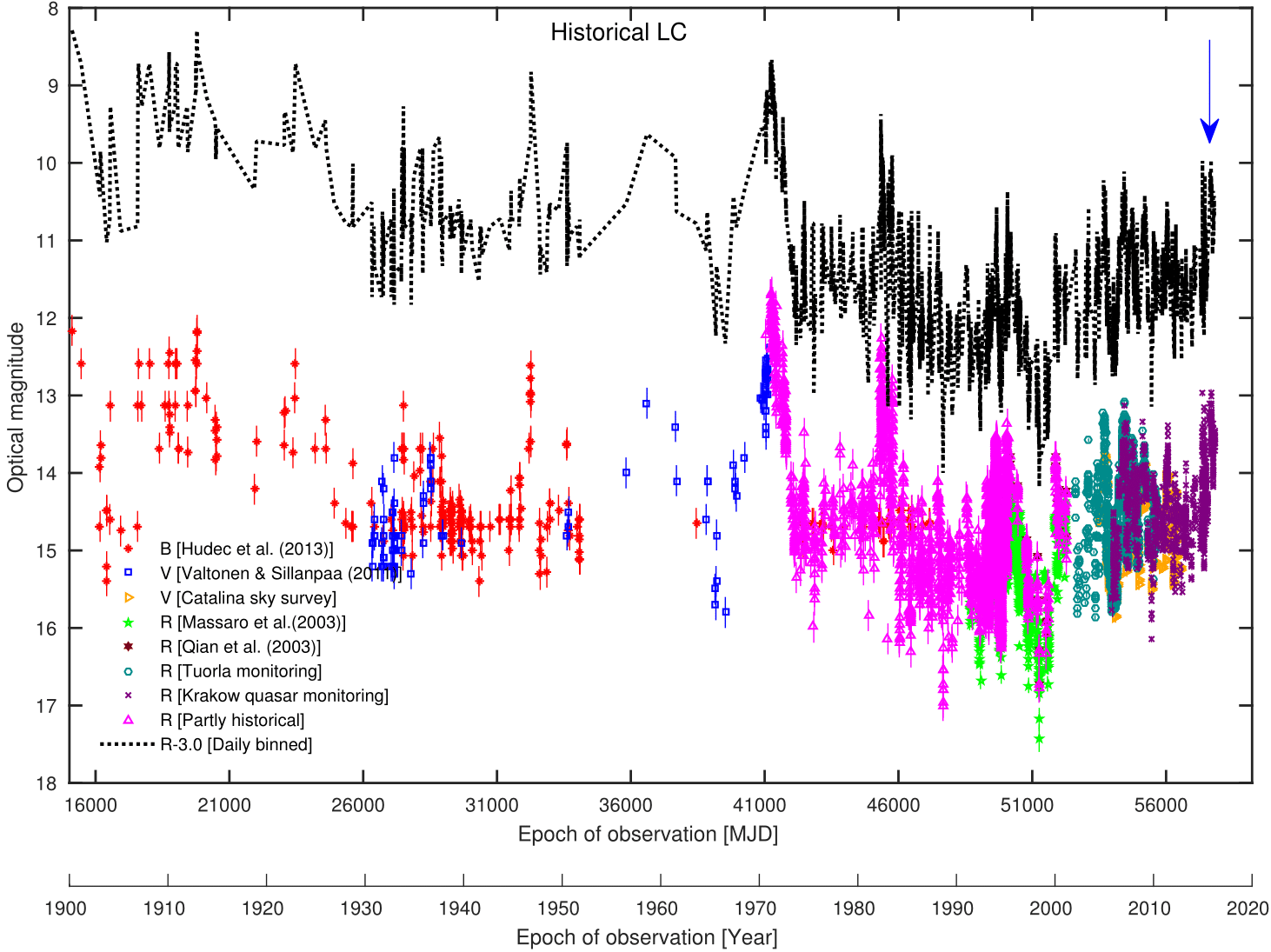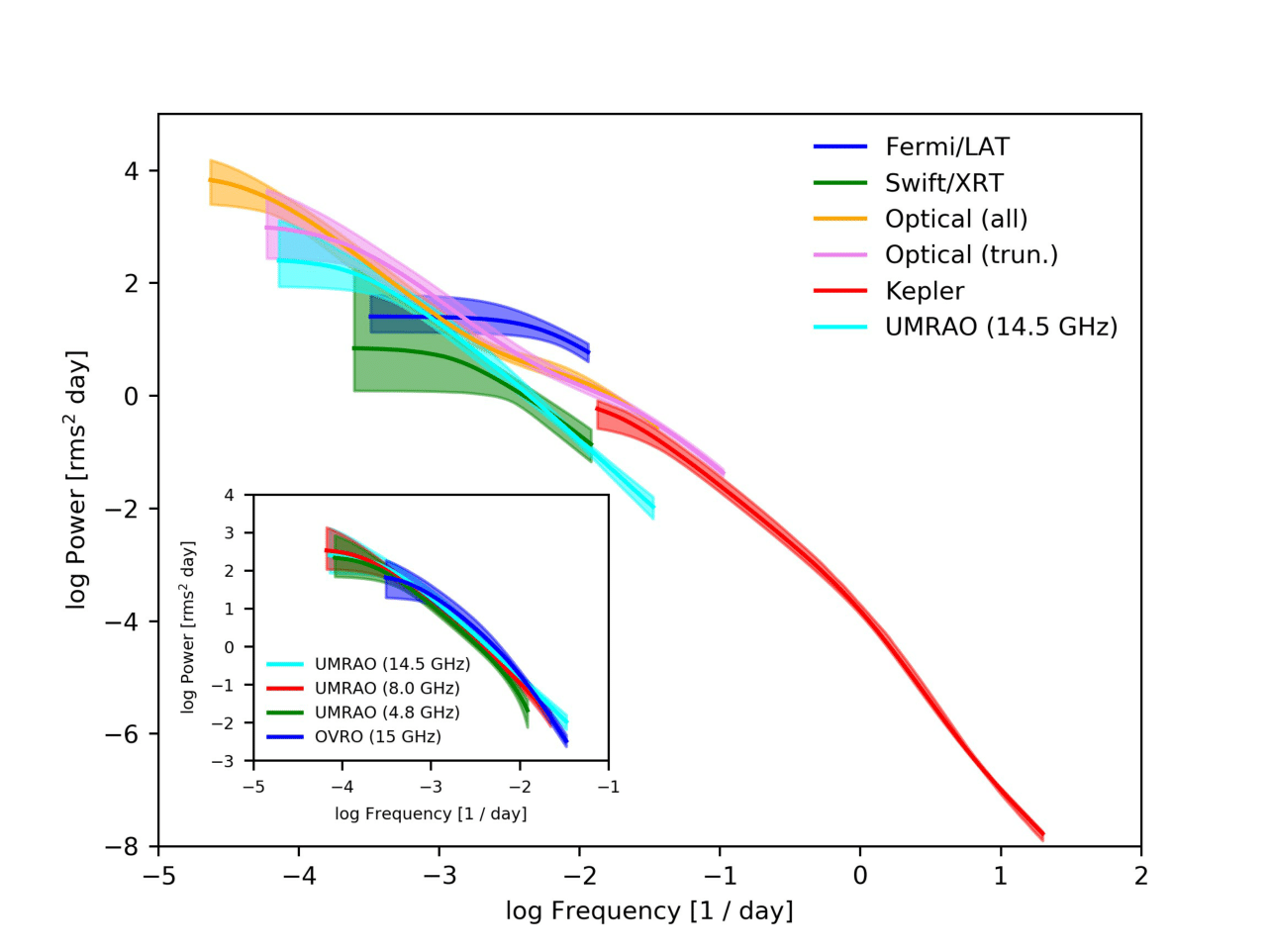Astronomy Object of the Month: 2018, July
< previous Archive next >
First long term all-frequency power spectral analysis of OJ 287
OJ 287 is a BL Lac object located 3.5 billion light-years away in the Cancer constellation. It produces quasi-periodic optical outbursts
going back approximately 120 years, as first apparent on photographic plates from 1896. Its optical light curve shows a quasi-periodic
oscillation consisting of two narrow peaks with period around 11–12 years. This behaviour has been interpreted as a signature of a presence
of a binary supermassive black hole system consisting of two black holes of widely different masses (1010 and 106 solar masses). The
double-burst variability is believed to result from the smaller black hole punching through the accretion disc of the larger black hole every
12 years. The international team headed by Dr Arti Goyal from the Astronomical Observatory of the Jagiellonian University conducted
the first long term all-frequency power spectral analysis for OJ 287, using also the data from Kepler satellite and constructing the
optical variability power spectrum without any gaps. The results are published in The Astronomical Journal.
 Figure 1: The long-term optical light curves of OJ 287, including the historical and also newly acquired measurements. Various symbols denote the original data for the given filter used in the observations. The blue arrow indicates the maximum of the giant outburst seen in 2015 and the black dotted line (shifted upward for clarity) traces
the corresponding R-band flux evolution assuming fixed color differences. Credit: the Authors.
Figure 1: The long-term optical light curves of OJ 287, including the historical and also newly acquired measurements. Various symbols denote the original data for the given filter used in the observations. The blue arrow indicates the maximum of the giant outburst seen in 2015 and the black dotted line (shifted upward for clarity) traces
the corresponding R-band flux evolution assuming fixed color differences. Credit: the Authors.
Blazars are a major class of active galactic nuclei (AGN), whose total radiative energy output is dominated by the Doppler-boosted, broad-band, non-thermal emission of relativistic jets launched by accreting supermassive black holes of massive elliptical galaxies. They include BL Lacertae objects and high polarization quasars, which constitute a subset of flat-spectrum radio quasars characterized by high optical fractional polarization. The radio-to-optical/X-ray part of their emission in continuum is likely due to synchrotron radiation of electron-positron pairs accelerated up to ∼TeV energies, while the high-frequency X-ray-to-gamma-ray segment is widely believed to be due to the inverse-Comptonization, with various photon fields gaining energy at the expense of the electrons of the jets. Alternatively, in the ‘hadronic’ scenario, this high-energy emission can also be generated by protons accelerated to ultra-high energies and producing gamma rays via direct synchrotron emission or meson decay and synchrotron emission of secondaries from proton-photon interactions (IceCube Collaboration et al., 2018, Science, see also the original paper).
Blazars display strong flux variability at all wavelengths, on time scales ranging from minutes and hours to decades. The shapes of the power spectral densities of blazar light curves indicate that the observed flux changes at given photon energy ranges are correlated over temporal frequencies. However, so far little or no evidence has been found for flattening of the blazar variability power spectra on the longest timescales covered by blazar monitoring programs (years and decades), even though such flattening is expected in order to preserve the finite variance of the underlying (uncorrelated by assumption) process triggering the variability. Breaks in the power spectral density slope reported in a few cases may also hint at characteristic timescales related to either a preferred location of the blazar emission zone, the relevant particle cooling timescales, or some global relaxation timescales in the systems. Detection of such break features in blazar periodograms would be of a primary importance for constraining the physics of blazar jets.
However, the blazar light curves from ground-based observatories always sample limited temporal frequencies due to weather and visibility constraints. This is particularly severe at optical and high-energies. This difficulty has recently been surmounted in the optical range with the usage of Kepler satellite data, though only for limited numbers of blazars.
OJ 287 is a typical example of a ‘low-frequency-peaked’ BL Lacertae blazar with positive detection in GeV and TeV energy range. A supermassive binary black hole is claimed in the system, based on the evidence for a∼12 yr periodicity in its optical light curve (Valtonen et al. 2008, Nature). OJ 287 is also one of the few blazars for which good-quality, long-duration optical data are available, dating back to circa 1896 (thanks to old astronomical plates, see Figure 1). Luckily, it is also one of the few blazars which have been monitored by Kepler satellite for a continuous monitoring duration of 72 days, with only 1 minute cadence. Hence, OJ 287 is an outstanding candidate to characterize statistical properties of flux changes on the timescales ranging from minutes to 100 years.
Dr Arti Goyal is the first author of the new paper presenting the results of multiwavelength power spectral analysis for OJ 287, supplementing the optical data with other frequencies such as Fermi-LAT survey (gamma waves), Swift (X waves range), and GHz-band radio telescopes (Figure 2). Due to the inclusion of the Kepler data, the authors were able to construct for the first time the optical variability power spectrum without any gaps.
 Figure 2: Multiwavelength variability power spectra of OJ 287; the shape
of high energy gamma ray variability is considerably different (flat on timescales longer than 155 days) from those at X-rays, optical and
radio frequencies. Credit: the Authors.
Figure 2: Multiwavelength variability power spectra of OJ 287; the shape
of high energy gamma ray variability is considerably different (flat on timescales longer than 155 days) from those at X-rays, optical and
radio frequencies. Credit: the Authors.
The analysis reveals that the power spectra derived at radio frequencies are of a colored-noise type (less and less variability on progressively shorter timescales) on the timescales ranging from tens of years down to months. The overall optical power spectrum is also consistent with a colored noise on the variability timescales ranging from 117 years down to hours, with no hints of any quasi-periodic oscillations. The X-ray power spectrum resembles the radio and optical power spectra on the analogous timescales ranging from tens of years down to months. Finally, the high-energy gamma ray power spectrum is noticeably different from lower energies, with the evidence of characteristic relaxation timescale in the Fermi-LAT data, corresponding to ~150 days. The diversity in the multiwavelength power spectra of the studied blazar indicate a complex nature of blazar variability which is difficult to reconcile within the context of currently known blazar emission models.
Original publication: A. Goyal et al. 2018: Stochastic modeling of multiwavelength variability of the classical BL Lac object OJ 287 on timescales ranging from decades to hours, Accepted for publication in The Astrophysical Journal(July 2018).
The project is part of research conducted at the Department of High Energy Astrophysics and the Department of Stellar and Extragalactic Astronomy of the Jagiellonian University’s Astronomical Observatory (OAUJ). The research team from OAUJ included: Arti Goyal, Łukasz Stawarz, Stanisław Zoła, Volodymyr Marchenko, Marian Soida, Michał Ostrowski, Bartłomiej Dębski, Dorota Kozieł-Wierzbowska, Elżbieta Kuligowska, Tomasz Kundera, Sebastian Kurowski i Urszula Pajdosz.
|
Arti Goyal Astronomical Observatory Jagiellonian University Arti.Goyal [at] uj.edu.pl |
Łukasz Stawarz Astronomical Observatory Jagiellonian University Stawarz [at] uj.edu.pl |


